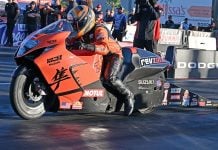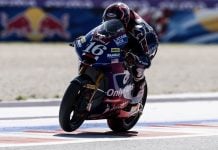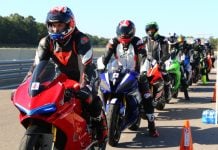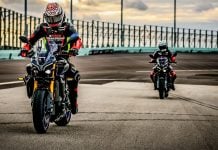First Person/Opinion:
By Jay Sherritt
Marta Michell, the widow of 2017 American Motorcyclist Association Hall of Fame nominee Merlyn Plumlee, was in Colorado for a weekend this past May and set up a lunch date with my wife, Leah, on Friday, the 12th. I joined them, together with Marta’s husband, Tim, at the dining hall of the beautiful Colorado Chautauqua National Historic Landmark here in Boulder, a short walk from where I grew up. We shed more than a few tears, and talked of many things. Included in our discussion were, of course, Merlyn, but also Earl and Nicky Hayden, John Ulrich, and the American Motorcyclist Association Hall of Fame. It was very clear how meaningful it would be to Marta that Merlyn be inducted into the Hall of Fame. Those of us who were fortunate enough to have known Merlyn would certainly agree.
Looking back over the events that would unfold over the next three days, our conversation seems to have been eerily prescient.
. . .
Merlyn Plumlee lost his battle with cancer in 2007. From his final tribute in Roadracing World (with credit to American Honda, article at https://www.roadracingworld.com/news/rip-merlyn-plumlee/):
“Merlyn is widely regarded as one of the greatest tuners in the history of American road racing. Always first to shake a competitor’s hand in victory or defeat, Merlyn was a gentleman in an often violent sport. His friendly demeanor melted the lines drawn between competitors. Merlyn was respected by all and his friendship was cherished throughout the paddock.
“Merlyn began working in the American Honda race shop in 1982, when he attended his first national road race, the Daytona 200, as part of the Honda factory team. Merlyn was known for working his magic with machines and riders alike, and this talent helped nurture some of the greatest riders in the history of the sport: Steve Wise, Freddie Spencer, Fred Merkel, Scott Russell, Doug Chandler, Simon Crafar, Mike Hale, Wayne Rainey, Bubba Shobert, Ben and Eric Bostrom, Jake Zemke and Nicky Hayden.”
. . .
A fortunate few of us sprouted our racing roots in Colorado. For dirt racers, of course, we have the Pikes Peak Hill Climb, but I can think of no better road racing experience than those races that were held in the mountain ski resort towns once or twice a year. The Steamboat Springs races brought out the very best of the spirit of racing. Rather than being a racetrack experience, they were a racing community experience. We filled condos, ate together, partied together, bench raced together, and yes, rode and raced side-by-side on roads winding through alpine meadows and condominiums. Racers worked together more than against each other. The thrill of briefly busting loose both ends through the gravity-cavity of a steep, uphill intersection’s right turn, or having the rear step out at 100+ cresting an off-camber hill on a four-lane, divided street can never be erased from memory. During winter we call sharing the experience après ski, but in summer the après race evenings at the Tugboat bonded it all together, and bound us all together.
. . .
In 1991 a few local racers, together with Leah and I, assembled a team and took ourselves racing on the national tour. Our team was all-volunteer. Unlike most of the teams we were racing with and against, we had no payroll and no contracts with riders or crew. We were, however, either good enough or lucky enough to attain some success. We were solicited to help fill the field in a World Superbike race that year, and with some talented riders managed to emerge with a couple spots on the AMA grading list and some WSB points. With the necessary credentials in hand, we decided to go World Superbike racing, or at least go and race the only other race we could drive to. (Imagine Leah driving a Jeep from Boulder to Brainerd, pulling a dirt bike trailer with a road race bike on it. It happened.)
When we went out to the pit road for our very first WSB practice session, there was a Colorado homeboy, Merlyn Plumlee, inseparable as always from his clipboard, in the adjacent pit. Unlike us, however, with our mostly stock Superbikes, he was standing next to two-time WSB Champion Fred Merkel, sitting on an Italian team’s full-blown, competitive World Superbike.
Looking back over the years, I’ve come to realize that there was a much bigger, more important difference between our efforts and Merlyn’s. While we were there to take what we could from the national (and world) racing experience, Merlyn was there to bring to the world the spirit and magic of his local roots.
. . .
As Leah and I drove back home from Chautauqua, Leah suggested that I undertake trying to get Merlyn on the 2018 AMA Hall of Fame ballot. She reasoned that I do like to write, and that the campaign would probably involve a lot of writing. I also felt strongly for Marta, and simply felt that it would be the right thing to do. I was, however, completely ignorant to the process, so I began researching what would be involved. Simply put, the criteria weren’t well aligned with Merlyn’s role in racing. Also, the field of deserving candidates is enormous, and many are much more well known to motorcycle enthusiasts than Merlyn. Perhaps some are even more deserving.
Only two candidates are selected each year from the competition category, and although the criteria make provisions for “tuners,” Merlyn wasn’t so much of a tuner in the classical sense. Let’s face it. Merlyn was a wizard, a magician, a catalyst that integrated the rider and the machine, and also helped bind a team in many ways. The induction process doesn’t have a category for wizards. He was the consummate hidden teammate behind many Hall of Fame champions, but his behind-the-scenes participation is problematic when it comes to the induction process. The application form wants “Support materials and copies of media coverage highlighting the applicant’s achievements” attached. Leah suggested that I contact John Ulrich and see if he knew of any media coverage of Merlyn. Not likely to produce much, I thought.
Again, being ignorant of the process and other goings on, I began to contemplate whether or not to indulge an effort to get Merlyn on the ballot anyway. I didn’t hold out much hope for success, but sometimes, futility aside, you just have to drive forward and do your best anyway.
Two days later (May 14), this would all prove to be irrelevant. I received a Hall of Fame ballot notification from the AMA, and when I logged on to the voting site, Merlyn’s name was on the ballot. Obviously, someone else had already done the groundwork.
. . .
Leah was looking over my shoulder while I was voting, probably because I let out a scream that was loud enough for her to hear upstairs when I first read the ballot. You could vote for up to two candidates from the competition category. The other name that got my immediate attention was John Ulrich. Leah said “You have to vote for John.” I didn’t. I explained that game theory, and the mathematician in me, made me optimize my strategy and prevented me from potentially being the one who cast the one extra vote for John that could cause Merlyn to lose out to him. From my past experience racing against John’s teams, I figured he would appreciate that. Every strategic decision he made was made with one goal in mind–winning. Others might consider my not voting for them an insult, he would consider it a complement.
I was a little disappointed that John was there on the ballot soaking up votes and a spot in the competition category. He was a competitor, certainly, but he was a lot more. He could very well have been categorized under “Ambassador/Industry,” given his lifelong involvement. You have to go back to his days as a Cycle World contributor, his decades as a publisher, his track safety campaigns and you realize that his contributions in service to the industry and as an ambassador are more significant than just as a competitor. I felt (once again prescient) that he was more deserving of some sort of lifetime achievement award. His high-profile public presence was enough to virtually assure him of being elected to the Hall of Fame in any category. I, and for all I know even perhaps John, would prefer that his election didn’t happen at the expense of excluding Merlyn.
John also served a much more important role in racing, and for a term with the AMA as a director. Some would label him an antagonist, but I would characterize him as one who is dedicated to the unvarnished truth. It is essential to the health of any organization that there be a balance with reality, and especially to non-profit organizations that can easily become dominated by good-ole’-boy appointments. Warts and all. Ignoring reality is much more destructive than facing the adversity that is intrinsic to activities such as motorcycling. John’s service in that role, in and of itself, deserved the highest recognition, no matter how painful his participation might have been to the status quo. (I congratulate John on being an inductee into the AMA Hall of Fame, and on his being recognized for his lifetime of achievement. Thank you, John.)
. . .
The next day (May 15), we all received the news that Nicky Hayden was involved in a very serious bicycle accident while training in Italy. Marta, Leah and I had talked about Nicky and Earl the previous Friday, and delved into some past experiences with Nicky that illustrated some remarkable character for such a young competitor. I had also reflected on the last time that I had had a long discussion with Earl, at Road America about fifteen years ago, on what for him had been a bad day. With tears in his eyes, he told me how fortunate I was that my son didn’t pursue racing. For Earl, there were a lot of ups and downs, but the downs bore especially heavily on him. A week later we would learn of Nicky’s passing.
. . .
Per the quote above, Merlyn’s ”friendship was cherished throughout the paddock.” It’s difficult to express how much of an understatement that is. The man simply warmed your heart. When dealing with factory teams, you expect haughtiness, deception, gamesmanship, but seldom candor on racing matters. Merlyn was the exception. He offered advice, but he also gleaned experience from others. He wasn’t into the voodoo, psyche, and trendiness that can dominate some competitors. His knowledge was comprehensive but he was always looking to learn. You could do no better than to accept his opinion. He was genuine, in more ways than one.
The last time I saw Merlyn was at California Speedway, when I was gleaning some technical matters from the factory players for consideration in the upcoming rulebook. When it came time to visit Honda, Kevin Erion ducked in his trailer for a minute, and came out with Merlyn. Everyone I had dealt with that day had been wonderful, but it’s difficult to put into words how overjoyed I was to see Merlyn. There was no one I would have rather dealt with. (Sorry, Kevin.) His poor health had weighed on me for quite a while, but that day he looked great, sounded great, and I was thrilled to see him back to being involved in that capacity. It was not long after that that I heard he had passed.
Merlyn, with Marta’s support, had chosen to live his life as a competitor, on the road, with the paddock community as his home.
I have more than a few friends in the Hall of Fame, and others that will be easily elected the first year they are eligible. I’m pretty sure that they believe Merlyn is worthy of their company. He wasn’t invisible to them.
Jay Sherritt
Boulder, Colorado
(Editorial Note: John Ulrich voted for Merlyn Plumlee…)






